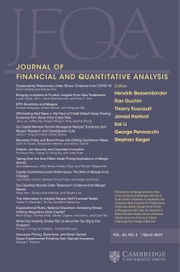Article contents
Are Shadow Rate Models of the Treasury Yield Curve Structurally Stable?
Published online by Cambridge University Press: 11 December 2023
Abstract
We examine the structural stability of Gaussian shadow rate term structure models in a sample of Treasury yields that includes the “effective lower bound” (ELB) period from 2008 to 2015. After highlighting the challenges of testing for structural breaks in a latent-factor model, we proceed to document various pieces of empirical evidence for a structural break. As one of several practical implications, the expected policy rate paths during ELB years are notably shallower in our model that accommodates a structural break compared with a model that imposes structurally stability.
Information
- Type
- Research Article
- Information
- Journal of Financial and Quantitative Analysis , Volume 59 , Issue 7 , November 2024 , pp. 3500 - 3530
- Creative Commons
- This is a work of the US Government and is not subject to copyright protection within the United States. Published by Cambridge University Press on behalf of The University of Washington
- Copyright
- © Don H. Kim and Marcel A. Priebsch outside of the territories of the USA, 2023.
Footnotes
This article has evolved from our earlier preliminary working paper entitled “Estimation of Multi-Factor Shadow Rate Term Structure Models.” The analysis and conclusions set forth in this article are those of the authors and do not indicate concurrence by other members of the research staff or the Board of Governors of the Federal Reserve System. We thank an anonymous referee, Hendrik Bessembinder (the editor), Michiel De Pooter, Marco Giacoletti (a referee), Edith Liu, Andrew Meldrum, Hiroatsu Tanaka, Jonathan Wright, and seminar participants at the Federal Reserve Board for helpful comments.
References
- 4
- Cited by

